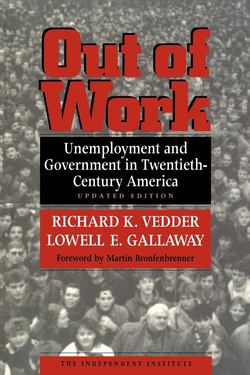Читать книгу Out of Work - Richard K Vedder - Страница 24
Underconsumptionist and Income-Expenditure Approaches
ОглавлениеThe demand for labor services is ultimately derived from the demand for goods and services: labor markets are impacted by product markets. At the same time that modern neoclassical and Austrian economics was evolving at the turn of the century and beyond, a different explanation of business fluctuations and unemployment was put forward. The alternative theory placed most of the blame for declines in business activity on inadequate spending, either consumption or investment. Until the 1930s, these theories were generally dismissed by neoclassical economists as being superficial and mistaken. With John Maynard Keynes’s General Theory of Employment, Interest and Money (1936), however, the underconsumptionist approach rose to a position of dominance among economists.
Among the pre-Keynesian writers, John Hobson and, at a more popular level, William T. Foster and Waddill Catchings emphasized the importance of demand for products in the maintenance of prosperity.14 This, in turn, implied that adequate purchasing power was necessary to sustain production and full employment. Implicitly, these writers rejected the classical/neoclassical propositions of Jean Baptiste Say that “supply creates its own demand.”15
In his General Theory, Keynes did not actually reject the appropriateness of the simple wage theory as outlined in figure 2.1, but he did reject the notion that reductions in money wages were likely to succeed in restoring full employment. He pointed out that money wages were often rigid, set by contracts, making rapid wage adjustments infeasible. However, even if money wages were somehow reduced, the marginal cost of producing goods would decline, increasing product supply and lowering the prices of goods. Thus, as wages fell prices would likewise fall, causing the demand-for-labor curve to shift to the left, and leaving real wages essentially unchanged. Thus a policy of wage reduction was not likely to be effective in restoring a full employment equilibrium.
Keynes argued that unemployment can be reduced, however, by stimulating the aggregate demand for goods and services. If, at existing income levels, people increase the amount they wish to spend, this will lead to both increased output of goods and an increased demand for labor. In the context of figure 2.1, the demand-for-labor curve can be shifted rightward by increased demand for goods and services.
How does one stimulate aggregate demand? By engaging in such fiscal policy actions as increasing levels of government spending or by increasing people’s disposable (after-tax) income by simply lowering taxes. Either increased government expenditures or reduced taxation serves to increase the budget deficit of the government. Thus deficit government financing will stimulate aggregate demand (consumption, investment, government, and net export spending), thus increasing the demand for labor, reducing unemployment.
In classical and neoclassical economics, saving was viewed as a positive economic act, since the act of saving ultimately stimulated investment by lowering interest rates, and thus enhanced capital formation, productivity, and real output. In Keynesian economics, however, saving took on a negative connotation. Higher saving meant a reduced “propensity to consume,” and with that, a reduced aggregate demand for goods and thus a reduced demand for labor. Surges in consumer saving meant sudden reductions in the aggregate demand for goods, with the initial decrease in consumption (arising from more saving out of a given income) getting multiplied several times as the chain reaction impact of reduced spending spread throughout the economy.
The stimulus to aggregate demand from deficit-financed government fiscal actions would directly raise the demand for labor, the Keynesians believed. In addition, increased demand for goods would lead to increased prices, particularly in sectors where the economy was already operating near capacity. Higher prices, in turn, other things equal, meant lower real wages. Thus inflation, previously viewed as an evil that reduced the efficiency of the price mechanism as an allocative device, was somewhat virtuous. A generation after Keynes, A. W. Phillips developed the famous Phillips curve which, as modified by others, stated that higher rates of inflation are associated with reduced rates of unemployment.16
While Keynes very explicitly discussed the neoclassical approach to unemployment, he nonetheless believed that cyclical fluctuations were largely related to financial and capital markets, not the labor market. Neoclassical economists argued that another key price—the interest rate—could adjust to resolve problems arising from sudden reductions in consumer or investment spending. If people tried to save (not spend) more than businesses wanted to invest for new plant and equipment, a reduction in economic activity would be thwarted by falling interest rates. Keynes argued that was not necessarily so, introducing the concept of the “liquidity trap” where interest rates would not fall beyond a certain point. Moreover, lowering interest rates was of limited effectiveness in increasing aggregate demand, since investment spending was not all that sensitive to interest rates anyhow.
The classical or neoclassical economic models argue that Keynesian views that government-induced increases in economic activity can stimulate aggregate demand are wrong. Suppose the government increases its spending, financed by borrowing. Increased demand for loanable funds would raise interest rates, lowering investment spending. Higher interest rates would also increase savings, lowering consumption. Increases in government spending would be offset by declines in investment and consumption spending, leaving aggregate demand unchanged. Thus demand-side intervention is inherently ineffective.17
Returning to a comparison of the Keynesian and neoclassical perspectives, Keynes never went so far as to say “wages do not matter,” but he implied there was little one could do about wage levels in a policy sense. Later Keynesians increasingly ignored wages or even implied that unemployment was negatively related to wage levels.18 Generally, in the 1950s and 1960s, the subject of wages was seldom even mentioned in discussing the issue of unemployment. Essentially the view had become, “Wages don’t matter,” almost in direct contrast to the neoclassical position that almost said “Wages alone matter.”
